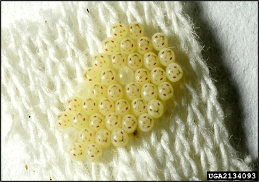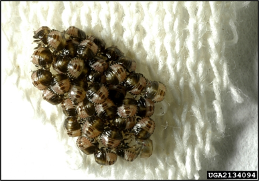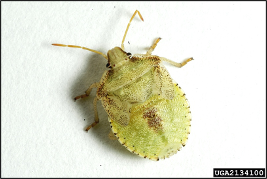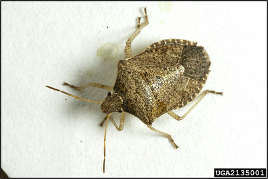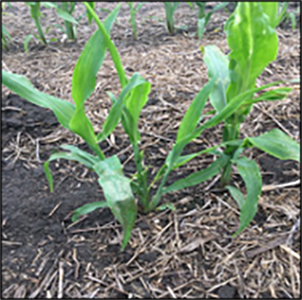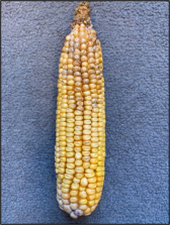There are several pest species of stink bugs found in the southeastern United States, including the green stink bug, Chinavia hilare, the southern green stink bug, Nezara viridula, the rice stink bug, Oebalus pugnax, and brown marmorated stink bug, Halyomorpha halys. One of the most common species is the brown stink bug, Euschistus servus (Say). The brown stink bug is a pest of numerous cultivated crops, including soybean, cotton, and corn. The brown stink bug is a native species in a large portion of the United States and has historically been considered a sporadic pest of many cultivated crops. Due to farm management practices, such as reduced and no tillage, favoring large overwintering populations, and reduced use of broad-spectrum insecticides, the brown stink bug has become a perennial pest in many cases. Field corn is particularly susceptible to injury from brown stink bug, which can occur throughout much of the growing season.
Identification
Eggs of the brown stink bug are cylindrical and laid in clusters of around fourteen to forty-two eggs. Eggs are translucent yellow, and the top of each egg turns pink as it matures (figure 1). The brown stink bug develops through five nymphal stages or instars. Nymphs are similar in appearance to adults, except that they are smaller and lack wings. First instars congregate on the egg mass and begin to disperse as second instars. Early instars are brown to black (figure 2), and as they mature, begin to turn light greenish yellow with some brown on the margins (figure 3). Nymphs of the brown stink bug have a characteristic longitudinal brown patch on the ventral (top) side of the abdomen that can help distinguish it from other similar stink bug species (figure 3). Adult brown stink bugs are brownish-yellow, shield-shaped insects measuring 10-15 mm long and 7-9 mm wide (figure 4). The ventral side (underside) of adults is green initially and slowly turns yellowish-brown as they reach maturity.1,2
Life Cycle
Brown stink bugs overwinter as adults in crop residues, leaves, weeds, and crevices in trees. They produce two to three generations per year and generally are active from April through October. It takes four to five weeks, on average, to complete the life cycle from eggs hatching to a mature adult.2 Often, the first generation each year will feed and oviposit in a weedy host or a winter crop host, such as wheat. Manipulation of weedy borders along corn fields has not been found to influence populations of the brown stink bug in corn, suggesting that other hosts, such as wheat or woodlands, are more important overwintering and early season hosts.3 The second generation will migrate into field corn. Migration of brown stink bugs from winter wheat into corn before or during wheat harvest is well documented, and wheat can be a significant source of infestations during susceptible stages of corn development.4
Injury to Corn
Stink bugs have piercing-sucking mouthparts and excrete digestive enzymes into plant tissue when feeding. A combination of mechanical injury from inserting mouthparts and physiological injury from digestive enzymes causes injury throughout the season to corn. Corn is susceptible to injury at several stages throughout its development. Descriptions of each growth stage of corn can be found in Ritchie et al. 1986.5 From emergence through around the six leaf stage (V6), stink bugs feed directly on the growth point of developing plants and can cause stunting, tillering, and plant death in severe cases (figure 5 and 6).6–9 Early injury from stink bug feeding ultimately results in yield loss. Several weeks prior to tasseling, during the ear elongation stages of corn, stink bugs feed through the stalk on developing ears, which leads to deformed ears and reduced kernel weight (figure 7). Once the ear emerges, during the first two reproductive stages of development (R1-R2), ears are susceptible to direct kernel injury from stink bug feeding, resulting in discolored or aborted kernels (figure 8).10 Stink bug feeding during late vegetative and early reproductive stages of can also introduce entry points for fungal contamination, reducing the quality of harvested grain.11
Management
Economic Thresholds and Chemical Management
Brown stink bugs can be controlled with insecticides and, the timing of application and coverage are critical for effective control. Sampling of cornfields should be conducted to determine if brown stink bug infestations are either above (treat) or below (do not treat) economic thresholds, which are one per ten plants from V1 to V6, one per eight plants from V14 to VT, and one per four plants from R1 to R2.
As an alternative to a fixed sampling plan, where a predetermined sample size is chosen (for instance, twenty-five plants in a row at four locations in a field), a sequential sampling plan was developed based on research conducted at North Carolina State University that consists of adjusting sample size based on the number of stink bugs found during initial samples. The advantage of sequential sampling plans is that it can reduce sampling time compared with a fixed sample size.
In addition, scouting time can be reduced by sampling only the areas of the plant where brown stink bugs are most likely to be found.12,13 When using a sequential sampling plan, one hundred plants are scouted in a given field, and the total number of stink bugs are counted. If the number of bugs exceeds the given number, sampling should cease, and treatments should be applied; if it falls within the lower range, sampling should cease with no treatment applied; and if the number is in the intermediate range, sampling should continue until a decision can be made (table 1).
Table 1. Sequential partial plant sampling plan for brown stink bugs in corn. Sample 100 plants throughout the field, and, if the number of bugs falls within the “Take more samples” range, more samples need to be taken. If the number of bugs detected is below or above this range, stop sampling and follow the recommendation. Only the area described under “Area to sample” needs to be searched to accurately assess the infestation level.14
| Growth stages | Area to sample | Do not treat | Take more samples | Treat |
| V1 to V6 | Base of the plant on stalk below the lowest green leaf | ≤ 6 | >7 to 12 | ≥ 13
|
| V14 to R1 | Stalk from first leaf above and below the primary ear | ≤ 4
|
>5 to 9 | ≥ 10 |
| R1 to R2 | Stalk at one leaf above and two leaves below the primary ear | ≤ 14
|
>15 to 27 | ≥ 28 |
When fields reach thresholds, most pyrethroids provide some level of control; however, bifenthrin provides the best control of brown stink bugs.15 Low residual activity and poor penetration into the canopy can lead to ineffective control in some cases, particularly late in the season.4 It is important to use the highest available rate, as well as proper pressure and volume, to allow the insecticide to penetrate the canopy and come into direct contact with target pests.
Several production guides recommend insecticide seed treatments for early season control of stink bugs. Research-based data on the efficacy of seed treatments against brown stink bugs are lacking; however, a large percentage of seed is pre-treated with seed treatments for a range of other pests.
Biological Control
Natural enemies of stink bug eggs have the potential to reduce populations significantly.16,17 Parasitoids are the primary species attacking stink bug eggs, and in some cases, predation by generalist predators can also be substantial. Telenomus podisi is the primary parasitoid species found in brown stink bug eggs in the Southeast.16,17 Parasitization rates of eggs generally range from 25% to 90% year to year, with some level of population reduction occurring. Parasitoids are highly susceptible to broad-spectrum insecticides often used for control of brown stink bug18, emphasizing the need for using insecticides only when populations reach damaging levels.
Summary
The brown stink bug is an increasingly common pest of field corn throughout the majority of the growing season. If left untreated, yield loss and quality reduction of corn grain can occur. Applying insecticide at the proper time (threshold) is the most critical aspect of managing brown stink bugs in corn.
References Cited
- McPherson JE, McPherson RM. Stink bugs of economic importance in America north of Mexico. Boca Raton (FL): CRC Press; 2000.
- Munyaneza J, McPherson JE. Comparative study of life histories, lab rearing, and immature stages of Euschistus servus and Euschistus variolarius (Hemiptera: Pentatomidae). Great Lakes Entomologist. 1994;26(4):263–275.
- Babu A, Reisig DD, Walgenbach JF, Heiniger RW, Everman W. Influence of weed manipulation in field borders on brown stink bug (Hemiptera: Pentatomidae) densities and damage in field corn. Environmental Entomology. 2019;48(2):444–453. doi:10.1093/ee/nvz016
- Reisig DD. Insecticidal management and movement of the brown stink bug, Euschistus servus, in corn. Journal of insect science (Online). 2011;11(168):168.
- Ritchie SW, Hanway JJ, Benson GO. How a corn plant develops. Ames (IA): Iowa State University Cooperative Extension Service; 1986. Spec Rep 48.
- Apriyanto D, Townsend LH, Sedlacek JD. Yield reduction from feeding by Euschistus servus and E. variolarius (Heteroptera : Pentatomidae) on stage V2 field corn. Journal of Economic Entomology. 1989;82(2):445–448.
- Apriyanto D, Townsend LH, Sedlacek JD. Feeding activity of Euschistus servus and E. variolarius (Heteroptera : Pentatomidae) and damage to an early growth stage of corn. Journal of the Kansas Entomological Society. 1989;62(3):392–399.
- Townsend LH, Sedlacek JD. Damage to corn caused by Euschistus servus, E. variolarius, and Acrosternum hilare (Heteroptera: Pentatomidae) under greenhouse conditions. Journal of Economic Entomology. 1986;79(5):1254–1258.
- Sedlacek JD, Townsend LH. Impact of Euschistus servus and E. variolarius (Heteroptera: Pentatomidae) feeding on early growth stages of corn. Journal of Economic Entomology. 1988;81(3):840–844.
- Ni X, Da K, Buntin GD, Cottrell TE, Tillman PG, Olson DM, Powell R, Lee RD, Wilson JP, Scully BT. Impact of brown stink bug (Heteroptera: Pentatomidae) feeding on corn grain yield components and quality. Journal of Economic Entomology. 2010;103(6):2072–2079.
- Opoku J, Kleczewski NM, Hamby KA, Herbert DA, Malone S, Mehl HL. Relationship between invasive brown marmorated stink bug (Halyomorpha halys) and fumonisin contamination of field corn in the Mid-Atlantic U.S. Plant Disease. 2019;103(6):1189–1195.
- Babu A, Reisig DD. Developing a sampling plan for brown stink bug (Hemiptera: Pentatomidae) in field corn. Journal of Economic Entomology. 2018;111(4):1915–1926.
- Babu A, Reisig DD. Within-plant distribution of adult brown stink bug (Hemiptera: Pentatomidae) in corn and its implications on stink bug sampling and management in corn. Journal of Economic Entomology. 2018;111(4):1927–1939.
- Reisig D, Heinger R. Stink bug management in corn. Raleigh (NC): NC State Extension; 2020.
- Babu A, Reisig DD. Efficacy of selected insecticides for managing brown stink bug in corn, 2019. Arthropod Management Tests. 2020;45(1):2020.
- Koppel AL, Herbert DA, Kuhar TP, Kamminga AK. Survey of stink bug (Hemiptera: Pentatomidae) Egg parasitoids in wheat, soybean, and vegetable crops in southeast Virginia. Environmental Entomology 2009;38(2):375–379.
- Tillman PG. Parasitism and predation of stink bug (Heteroptera: Pentatomidae) eggs in Georgia cornfields. Environmental Entomology. 2010;39(4):1184–1194.
- Koppel AL, Herbert DA, Kuhar TP, Malone S, Arrington M. Efficacy of selected insecticides against eggs of Euschistus servus and Acrosternum hilare (Hemiptera: Pentatomidae) and the egg parasitoid Telenomus podisi (Hymenoptera: Scelionidae). Journal of Economic Entomology. 2011;104(1):137–142.

